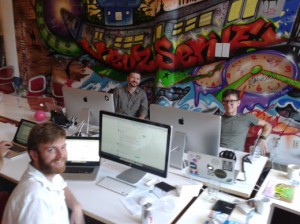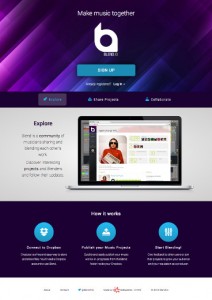Smart Startup: Blend.io — A Fresh Take on Creative Collaboration
For a medium built from the ground up for collaboration, the Internet hasn’t always come through – especially for musicians and music producers.
Pretty much since computers started plugging into each other, creative Web developers have tried to crack the code that would make new musical creations flourish, and eliminate geographical boundaries in the process. But these brave pioneers have found that facilitating Jamaica-to-Jakarta jamming isn’t as easy as it looks.
Kudos are certainly owed to the ambitious platforms that have come before. Some may remember the concerted efforts of Rocket Network, which launched in 1994, and tried hard to make real-time music collaboration happen until its demise in 2003. eSession, which sought to Webify hiring and collaborating with professional musicians and engineers, never overcame its own substantial hurdles and shut down in 2012 after a five-year run.
Myriad other spins, from eJamming to Indaba and beyond, can be found today offering up their own online solutions, all with varying degrees of interest from recording artists. But when you’re talking about the infinite dimension that is the Web, there’s always the prospect of a better mousetrap, and one may have just have emerged: Enter Blend.io.
Connecting and Sharing
Founded by technologist/music producer Alex Kolundzija, Blend’s launchpad is the active New York City company-builder Betaworks, which also houses the likes of Digg and Tapestry.is, Instapaper, Telecast and Giphy within its expansive offices in the Meatpacking District. A team atmosphere pervades the airy and open space – even among the markedly different companies who are at work there –the perfect place to make a new kind of creative hub.
“We want to encourage a group workflow for lot of people,” says Kolundzija, who previously worked for demanding employers such as Google and MLB.com. “The problem with DAW’s in general is that using them is a very lonely experience – it’s just you and your computer, you and your studio. But music is very collaborative, and that’s frequently missing. We’re hoping Blend will fill this gap, and allow distant people to make music together.”
Put simply, Blend launched in 2013 with the goal of allowing musicians and producers to share in-progress tracks, and connect with other musicians to collaborate. Registered users can browse artists and their projects, comment on their work, and remix each other’s tracks. The result is a community in perpetual beta, where dedicated music creators can seamlessly share and distribute their work – at any stage in the production.
One thing that social media mavens of all stripes have learned by now is to start small and strategically, then grow from there. On that tip, Blend is beginning with a focus on electronic music, via a platform that can currently accommodate users of Ableton Live and Native Instruments Maschine and will grow to support Reason, Garageband, Logic, Pro Tools and more as time goes on.
Social Music
Registered visitors start off with a not-unfamiliar social media experience (sign up now with the VIP code SONICBLEND to bypass the invite process and get instant access). Their personal landing page updates them on the latest music projects posted by fellow Blenders, suggests other producers to follow, invites them to publish a new project for group collaboration, and updates them on the latest status of any music projects they may already have posted – if someone has remixed their Live or Maschine arrangement, edited it, or just added a new effect, a listen to the latest take is just a click away.
While Blend offers up many engaging ways for users to interact within the community, the real magic happens in a Blender’s ability to pull down all of the components of another user’s Live or Maschine project, open it up on their own computer, and go to work on it themselves – starting with all the effects, automation, signal chains, and sounds the last producer left off with.
Conversely, a Blender can push a Live or Maschine project from their computer onto their profile, and allow everyone else in the Blend community who hears it and likes it to go to town with creative alterations to their song, loop, or sound bite. In turn, they push it back onto the site, and the whole process begins anew. A de riguer Creative Commons license for all of the material produced keeps things squabble-free.
Under the Soundcloud-like waveform player of each file, in addition to the expected “Like”, “Follow” and “Share” buttons is a “Pull” button, along with necessary information on the source files including the size, host program and version (Maschine 8.2.1 or Ableton Live 9, for example), tags denoting style/genre/project type (“Loop”, “Groove”, “Synthpop”, “Uptempo”) and any additional notes from the publishing producer.
Rethinking the Online Approach
The Blend approach aims to improve on two key frustrations that Kolundzija frequently experienced with other online collaboration tools.
“There have been attempts to recreate the DAW in the browser – I don’t want to do that,” he explains. “Ableton is an instrument, and asking someone to switch to Firefox or Chrome is hard. It’s like asking a bass player to play violin! We want people to continue to use the tools they’re comfortable with, and arrive at a collaborative workflow that allows them to work together more effectively.
“The idea is to be able see what other people are working on, team up and also learn from each other. I can’t tell you how many projects I’ve pulled on Blend, and discovered interesting production techniques for synthesizer or master channel routing, for example. And not only do I know that this technique exists, but I have it instantly. Imagine walking into a studio and hearing how Rick Rubin sets up his channels –then imagine being able to click a button and have that instantly. It doesn’t get better than that, right?”
See how to publish a project to Blend.io.
Kolundzija also feels no pressure to make things work in real time. “I’m not a huge fan of that,” he says. “I feel real-time has a place when it comes to communication and getting feedback. But part of the problem with communication and collaboration today is time. In a live band, we have to rent a rehearsal space, and we all have to get in the same room at the same time.
“But if we all work on our own time, we can be much more productive. Maybe I can work on something on my lunch break, or they’ll work on something when I’m sleeping. It’s about letting people work when they want to, using whatever they’re most comfortable with.”
Real Expectations for Revenue
The crowd-sourced creativity that’s possible here is clear to see. But how can it also help an artist’s bottom line? If a band or music producer is going to start investing time in a tool, then a possible revenue stream – not just more “exposure” — is reasonable to expect in return.
Kolundzija thinks that Blend can start factoring into an artist’s earning potential over time, and in hopefully significant proportions. The “Cred Board” on Blend’s site is the first step towards that, showing which Blenders are trending high due to their number of followers and level of activity. “If someone has a million followers,” Kolundzija says, “that’s part of the formula that results in how credible they are as a Blender. How well their updates to another Blender’s projects are received by their peers in the form of Likes, Plays, etc… is another very accurate metric.
“I mentioned how DAWs were a lonely experience, and the Internet can be as well. That’s part of the reason that social media has become so popular. When you’re on Twitter, for example, there’s a constant stream of updates. There’s nothing lonely about that, and it’s the same here: You can discover people, start following them and collaborating.”
If Kolundzija and his team of engineers, designers and community managers can steer it correctly, consistently high cred scores will start to correlate to monetization for Blenders. “Look at Nigel Sifantus aka DJ SEAP (a leader on the Cred Board), for example,” he notes. “Right now he’s got 97 followers, follows 471 Blenders, has 33 projects live, 74 project pulls (by other Blenders), 1275 plays, and 61 likes.
“If his updates to someone else’s project have been well-received, then that’s meaningful. We want to aggregate all these numbers and more into something like a credit score. So if I’m a singer/songwriter looking for a producer or bass player, and John Doe on Blend has a very good Cred score, I know I’ll get an excellent performance out of John. Plus, if he has a million followers on Blend, they’ll hear it. So to get John, I have to pay for that privilege. I can bid on his time, and he can decide if he wants the gig.
“Placement agencies represent another monetization model. If they’re looking for a certain kind of track for ‘Glee’ or a car commercial, that can happen through Blend – both the discovery and the fulfillment of it. Other possibilities include a distribution model for royalty free music, or a Blend radio. Fans can hear what’s going on, but also participate.”
It’s Sage to Engage
As Blenders multiply and recombine, Kolundzija will be paying close attention. He wants to uncover trends and patterns that will provide valuable information on how he and his team can keep improving Blend. In addition, the workflow tips they learn can be used to clue developers like Ableton and Native Instruments in on how to make their creativity tools even more groovy.
Along the way, he understands that patience with his musical/social network will be a virtue. “There’s an understanding, and I think it’s been validated,” he points out, “that if you have enough of a user base and engagement, it’s easier to monetize that.
“I think we have a solid idea of what the opportunities are to generate revenue, not just for us, but for musicians. If we can find a way to help people not just make money, but live from it – that’s the ultimate goal.”
By continuing to build Blend to his exacting standards, Alex Kolundzija just may succeed at that. “Sometimes you have to be critical of things,” he observes. “When it comes to tech products, it sometimes helps to put them into one of two categories: useful or useless. I want this to be useful. That’s the criteria I apply to each feature in Blend. Musicians really need something like this: That’s plenty of motivation for me right there.”
To Experience Blend: Sign up now with the VIP code SONICBLEND to bypass the invite process and get instant access. Say hi to SonicScoop on Blend while you’re there!
- David Weiss
Please note: When you buy products through links on this page, we may earn an affiliate commission.











DPrty
August 22, 2013 at 11:26 pm (12 years ago)Well first off .. Cockos Reaper should be on that list. Next .. I need to colab but will not put any of my work under creative
commons. I wish em the best but this sounds like its going to be just
another try.